
The sudden illness and passing of Georges Vezina in March of 1926 was a shock that threw the Montreal Canadiens for a loop. Very strong elements remained on the team, and a search had been undertaken to find a goaltender who would help the team reinstate its position among the NHL's better clubs.
The business of the NHL, and the collapse of the Western Hockey League would greatly assist the Canadiens in this task.
EXPANSION, 1920's STYLE
Due in part to the extinction of it's strongest professional rival league, the NHL was able to expand from 7 teams to ten in 1926-27. The WHL had been having trouble competing with NHL salaries, and folded under such pressure. They sold off the entirety of it's player assets to the NHL for a whopping $258,000.
The NHL board of governors ruled over the purchases in a meeting on September 25, 1926, transferring two WHL franchises into NHL squads. The Portland Rosebuds were rechristened the Chicago Blackhawks, and were owned by Major Frederic McLaughlin. The Victoria Cougars became the Detroit Cougars, and were owned by Charles A. Hughes.

McLaughlin was a Harvard grad who had served in the U.S. Army during World War I, achieving the rank of major. He named the team after his army unit, the 86th Infantry Blackhawk Division. Major McLaughlin made a deal with Frank Patrick to acquire 14 players from the Rosebuds for $100,000. The Major's story would intersect with that of the Canadiens owners in a few years, when he would need financial assistance to keep the Blackhawks afloat.
In all, there were enough quality players left over from the WHL sale to create a tenth team, that would become the New York Rangers.
These swooping changes left the NHL in sole possesion of not only the Stanley Cup, but also the greatest professional players in the game.
 A committee made up of Frank Calder, Leo Dandurand and James Strachan would distribute the remaining players amongst the ten NHL teams.
A committee made up of Frank Calder, Leo Dandurand and James Strachan would distribute the remaining players amongst the ten NHL teams. The Toronto St. Patricks themselves would purchase all but one player from the Saskatoon Crescents.
HAINSWORTH SLIPS THROUGH THE LEAFS FINGERS
That one player, goaltender George Hainsworth would become property of the Montreal Canadiens. The St. Patricks (soon to be renamed the Maple Leafs in mid season) believed they had Hainsworth in the deal, but the goalie had reached an agreement prior to the team sale and the NHL board ruled in the favor of the Canadiens.

A further assembling of NHL heads on October 26 decided the league would be split into five team Canadian and American divisions. Oddly, the New York Americans, much to the dismay of their owner, were placed in the Canadian Division.
The playoff format was also greatly altered and would feature the top team from each division meeting the winner of a total goals series between the second and third place teams from their divisions. The winners of those total goals series would then meet in a best of five series for the Stanley Cup.

The face of other NHL franchises were evolving as well, and the Toronto St. Patricks were purchased by Conn Smythe and renamed the Maple Leafs during the course of the season.
However, the team was contracted under the St.Patricks name for the 1926-27 season. They would become known as the Maple Leafs from the following season on.

Smythe began the season as the Rangers GM, but was replaced after a falling out with team owners. He did a commendable job in assembling a strong team for New York, and was ably relieved by Lester Patrick, who became as synonymous with Ranger success thereafter as would Smythe with the Maple Leafs.
A TROPHY IN VEZINA'S NAME
Georges Vezina was very much still on the minds of the Montreal Canadiens brass six months after his passing. Dandurand recalled that Vezina spoke highly of George Hainsworth from exhibition games, and had been impressed by his play. It is told that the Crescents goalie was his own suggested heir apparent. A further recommendation by former Canadiens star Newsy Lalonde sealed the Canadiens interest in Hainsworth.
 The Canadiens owners also brought forth the idea for a trophy in Vezina's memory honouring the NHL's best goaltender each season.
The Canadiens owners also brought forth the idea for a trophy in Vezina's memory honouring the NHL's best goaltender each season. In a unanimous vote, the NHL agreed the trophy would be awarded annually to the goalkeeper with the best goals against average.
Vezina thus became the first NHL player to have a trophy named for him.
NEWSY PLAYS HIS FINAL NHL GAME
With the folding of the western hockey leagues, several former NHL star players made their way back to the league in 1926-27 - and former Habs star Newsy Lalonde was no exception. Lalonde, who would have preferred to continue playing on in his twilight years, accepted the position of coach with the lowly New York Americans.
 The Americans never got going under Newsy, and even though he suited up for one final NHL game, Lalonde might have been the first prime example of a former star player not being able to translate his on ice understanding into a coaching capacity. The Americans finished fourth in the Canadian Division, seventh overall, with a 17-25-2 record. Lalonde would move on to coaching positions in the Can - Am league before resurfacing behind the bench of the Senators in the years ahead.
The Americans never got going under Newsy, and even though he suited up for one final NHL game, Lalonde might have been the first prime example of a former star player not being able to translate his on ice understanding into a coaching capacity. The Americans finished fourth in the Canadian Division, seventh overall, with a 17-25-2 record. Lalonde would move on to coaching positions in the Can - Am league before resurfacing behind the bench of the Senators in the years ahead.NINE NEW CANADIENS SUIT UP
Not unlike the season before, 9 new players would join the Canadiens in 1926-27, only this time, it had more to do with the surplus of talent around the NHL rather than weaknesses on the Canadiens team. New faces such as Ambrose Moran, Athur Gauthier, Peter Palangio, Carson Cooper, Arthur Gagné, Gizzy Hart, and Léo Lafrance would play for the club in 1926-27.
 Gagné, perhaps the most talented of the lot, was born in Ottawa, and had last performed with the Edmonton Eskimo's of the WHL in 1925-26.
Gagné, perhaps the most talented of the lot, was born in Ottawa, and had last performed with the Edmonton Eskimo's of the WHL in 1925-26. He'd had a career season with 35 goals, and contributed 14 for the Canadiens in this season. Gagne was on the Chicago roster and was acquired for cash on October 18, 1926.
Gagne would play three seasons for the Canadiens before being traded to Boston for cash on May 13, 1929.
Cooper was a 27 year old right wing who appeared in 14 games with the Canadiens, notching a very worthy 9 goals and 3 assists. He was in his third season with the Bruins when the Canadiens sent Billy Boucher to acquire him in a deal where either squad had the right to recall the players.
Cooper was worth the gamble, as had scored 28 goals for Boston in 1925-26. Both players did end up returning to their original teams on May 22, 1927.

Left winger Gizzy Hart was acquired from Detroit for cash on December 12, 1926, and later traded to Providence of the Can-Am league for cash, October 17, 1928. In his years with the Canadiens, Hart would score 6 goals, while appearing in 84 games.

Peter Palangio was an 18 year old prospect who had played with the North Bay Trappers of the NOHA in 1925-26, scoring 25 goals in 11 games. His production did not translate into the NHL, where he went scoreless in six games with the Canadiens. He signed on with the Canadiens as a free agent late in the season in February, and while he disappointed scoring wise, Montreal managed to get all kinds of mileage out of his trade wise. After going goalless in 4 playoff games with the Canadiens, Pelangio was traded twice to Can-Pro league teams for cash and a player, before being shipped a final time to London of the IHL for more cash on November 11, 1929.
 BILLY COUTU BANNED FOR LIFE
BILLY COUTU BANNED FOR LIFEThe Canadiens paid a hefty price for Ambrose Moran went they exchanged Billy Coutu for him in a pre-season deal with Boston on October 22, 1926. The 31 year old Moran had been a sturdy backlimer with the Vancouver Maroons over the past two seasons and didn't last long with the Canadiens, as they returned him to the Bruins on December 23 in a cash transaction. Coutu actually fared worse. After 40 games with Boston, he was involved in an altercation with an official, and became the first NHL'er banned for life from the league.
 Leo Lafrance appreared in but 4 games with the Canadiens in 1926-27 after being acquired from Duluth of the AHA for cash on November 10, 1926. He was suspended by the Canadiens two weeks later for leaving the team. Somehow, Montreal would hold onto his rights until 1936. In the interim, his rights were dealt a half dozen times for cash and loans.
Leo Lafrance appreared in but 4 games with the Canadiens in 1926-27 after being acquired from Duluth of the AHA for cash on November 10, 1926. He was suspended by the Canadiens two weeks later for leaving the team. Somehow, Montreal would hold onto his rights until 1936. In the interim, his rights were dealt a half dozen times for cash and loans.Arthur Gauthier was a 22 year old prospect who had been playing with the Galt Terriers in the OHA Sr. League when he signed with the Canadiens as a free agent on February 9. He went pointless in 13 games with Montreal and was traded to London of the Can - Pro league a year later.
GARDINER AN INSTANT MVP
The two biggest additions in 1926 to the Canadiens were Hainsworth and defenseman Herb Gardiner.
Hainsworth was no greenhorn when he joined the Canadiens. He was a veteran of 11 years with a pair of OHL Sr. teams - Berlin Union Jacks and the Kitchener Greenshirts - and had most recently been a standout with the Crescents of the WHL for three seasons.
At 31 years of age, he was in the prime of his career. He would play 7 seasons with the Canadiens and fittingly became the first winner of the Vezina Trophy, and award he owned for the first three seasons of it's existence.
Gardiner was so adept at his position that he almost singlehandedly filled the voids left by both Coutu and Sprague Cleghorn one season earlier. A dominant defensive defenseman that the Canadiens were well aquainted with from battles with the Calgary Tigers in the 1924 Stanley Cup final, they acquired his right just prior to the big WHL sell off in a cash deal with Calgary on October 20, 1926.
 In his first season in a Canadiens sweater, Gardiner so impressed with his play, that he was awarded the Hart Trophy as the NHL's MVP. Prior to his third season with Montreal, he was loaned to Chicago where he was named playing coach of Black Hawks in August of 1928. The Canadiens recalled the valuable veteran for the 1929 playoffs before trading his right to the Bruins for cash that spring.
In his first season in a Canadiens sweater, Gardiner so impressed with his play, that he was awarded the Hart Trophy as the NHL's MVP. Prior to his third season with Montreal, he was loaned to Chicago where he was named playing coach of Black Hawks in August of 1928. The Canadiens recalled the valuable veteran for the 1929 playoffs before trading his right to the Bruins for cash that spring. THE FLYING FRENCHMAN LEGEND TAKES ROOT IN THE U.S.
Perhaps the "Habitants" nickname helped spread a public curiosity of the team, with Howie Morenz on the verge of becoming the NHL first veritable superstar. The Canadiens "Flying Frenchman" myth was beginning to take hold and grasp the imaginations of American hockey fans, and Montreal were a big draw in every arena they appeared in. Both the Canadiens and the Maroons had the best home attendance in the NHL, but it was the fast skating Morenz and crew that fans turned out in large numbers to see on the road.
 The Montreal Daily Star, catching onto the team's speed mystique, sponsors intermission speed skating contests between Canadiens stars such as Morenz and Gizzy Hart verus the opponants fastest movers. Hundreds of dollars are at stake, often pocketed by the speedy "Stratford Streak".
The Montreal Daily Star, catching onto the team's speed mystique, sponsors intermission speed skating contests between Canadiens stars such as Morenz and Gizzy Hart verus the opponants fastest movers. Hundreds of dollars are at stake, often pocketed by the speedy "Stratford Streak".Morenz enjoyed a very good season with the Canadiens, scoring 25 goals, second only to the Rangers Bill Cook with 33.
A NEW COACH AND CAPTAIN
Above all the changes in the team's makeup, the look of the Canadiens behind the scenes was also given several unexpected facelifts.
 After Coutu was traded to Boston, the Canadiens named Sylvio Mantha the new team's captain. The team also had a new man behind the bench in Cecil Hart. After several seasons in the Canadiens organization, Hart took over from Leo Dandurand, who, on the advice of his doctors, relinquished the stressful duties. Dandurand had been a man for all purposes since taking co-ownership of the team, and he decided it would be better to focus his energies all in one place.
After Coutu was traded to Boston, the Canadiens named Sylvio Mantha the new team's captain. The team also had a new man behind the bench in Cecil Hart. After several seasons in the Canadiens organization, Hart took over from Leo Dandurand, who, on the advice of his doctors, relinquished the stressful duties. Dandurand had been a man for all purposes since taking co-ownership of the team, and he decided it would be better to focus his energies all in one place.REDS AND HORNETS BECOME THE HABS FIRST FARM TEAMS
Keeping Dandurand busy, was the establishing of the Canadiens first feeder teams in Providence and Windsor. The Reds and Hornets, respectively, played in the Can - Am league and Dandurand made agreements with each team that the Canadiens could sign their two best prospects annually. In exchange, Montreal would supply the Reds and Hornets with players, whether they be up and coming prospects or aging players that no longer fit their plans.

Gradually, this practice would evolve into the full fledged sponsorship of entire teams filled with Canadiens hopefuls.
HABS MOVE INTO FORUM AS MOUNT ROYAL ARENA SUES
The Canadiens finally left behind the old Mount Royal Arena for good in 1926. Renovations at the old arena ran into financial snags and delays, causing the team to begin playing its home games on the Maroons Forum ice. The Mount Royal offers the Canadiens $50,000 in damages for the inconvenience of renting the Forum while work is finished, but the team demands double the fee.

When no agreement is reached and the Canadiens sign a full time lease with the Forum, the Mount Royal counters with a $180,000 lawsuit for breaking their contract. The courts first favor the Mount Royal, but the Canadiens appeal the decision, which will later be settled in their favors.
With the NHL now playing a 44 game schedule, seasons begin in mid November and stretch until the final days of March.
CANADIENS START SLOW BEFORE HITTING THEIR STRIDE
The Canadiens might have had an even better season had they started off stronger. Three consecutive losses in which the team managed only one goal in each against Boston, Ottawa, and the Maroons set the tone for what would be an up and down first half of the season.
After 11 games, the Canadiens were a very ordinary and disappointing 4-6-1. As they hit the road for a three game swing, they began winning the close games, and mounted a four game winning streak that took them above the .500 mark for the first time. Just when it looked as though the team had turned the corner, another extended road trip saw them fumble four more games.
Nearing the mid season point with a record of 8-10-1, the Canadiens needed an injection of confidence only a winning streak could provide. It perhaps bode well for the club that it's next four games were against perceived weaker opponants. With the Americans, Maroons, Cougars, and St. Patricks all on the menu, the Canadiens settled into a groove for good with four stright wins.

From this point on, the Canadiens were practically unstoppable as they won 20 of their final 25 games. A 3-2 loss to the Rangers on January 27 was but a roadbump as Montreal went on to win the next three. They were 2-2-1 over the next five before finally hitting their stride from February 24 to March 24 with 11 straight wins.
A highlight was a 4-1 dumping of the Senators on March 15. Montreal had been unable to beat Ottawa in five meetings thus far and it looked as though there was no road around the Senators should the Canadiens wish to get back to the Stanley Cup.
HABS SET NEW TEAM MARKS
The Canadiens would finish the regular season, one of their best, with a record of 28-14-2 for 58 points. They are second in the Canadian Division, and overall in the league, behind the Senators who end with 64 points. The Canadiens 99 goals scored proved to be the second highest total in the 1926-27 season, behind the Blackhawks with 115.

Contrary to Chicago, who allowed one more goal than they scored over the course of the season, the Canadiens were excellent at keeping the puck out of their net. Montreal allowed a league low 67 goals against in 44 games, thanks in no small part to Hainsworth's amazing 13 shutouts and a tight defense led by Gardiner and captain Sylvio Mantha.
CANADIENS WIN BATTLE OF MONTREAL
While the first place Senators awaited a winner, a second versus third place battle of Montreal was underway between the Canadiens and Maroons. The two teams with the same home rink played a close two game total goals series and the stingy Maroons gave the Canadiens quite the fight. After the teams fought to a 1-1 knot, everything was on the line two nights later.

Howie Morenz capped a fine 25 goal season, by scoring the overtime winner against the cross town rivals to give the Canadiens a 1-0 win and the right to advance against Ottawa in another two game showdown.
SENATORS TOO STRONG
The Senators of the day boasted a lineup of stars with a wealth of experience. Cy Denneny, King Clancy, a young Hec Kilrea, Frank Finnigan, Hooley Smith, Frank Nighbor, Georges Boucher and Jack Adams, with Alec Connell in goal, were worthy of a Hall Of Fame lineup. The Senators, bevied by much Stanley Cup experience, stolled into the Forum and thumped the Habs 4-0. The 1-1 tie in Ottawa two evenings later was merely anticlimactic.

Ottawa went on to meet the champions of the American Division, the Boston Bruins in a best of five series for the Cup. Oddly, the Senators claimed Lord Stanley's mug without the benefit of gaining a third win. They'd won the second and fourth games of the hard fought series, while tying the first and third. Sudden death overtime would have only come into play in a fifth and deciding game.


HAINSWORTH WORTHY OF VEZINA
The Montreal Canadiens were hardly dispirited by the outcome of their season. One year prior, they were a seventh place team in a 7 team NHL, and were now a second place team in a much stronger 10 team league. The Canadiens were young and gaining in experience for the most part, and with all things taken into consideration, the one team they could not beat in this season won the Stanley Cup. Clearly better days were ahead.
 Much of the credit for the Habs resurgence in this season belonged to goalie George Hainsworth. The 31 year old puckstopper exceeded all expectations with an impressive 28-14-2 record in 44 games. His 14 shutouts led the league, and were one off from the NHL record set by Ottawa's Alex Connell one season prior.
Much of the credit for the Habs resurgence in this season belonged to goalie George Hainsworth. The 31 year old puckstopper exceeded all expectations with an impressive 28-14-2 record in 44 games. His 14 shutouts led the league, and were one off from the NHL record set by Ottawa's Alex Connell one season prior.Hainsworth was quite stingy in his first NHL campaign, allowing a league low 67 goals, for a goals against average of 1.47. Had Habs defenseman Gardiner not been named as the league MVP, Hainsworth would have merited the award.
Perhaps it was only fitting that he be named the inaugural winner of the Vezina Trophy, as he helped the Canadiens and their fans over the loss of their fallen hero. Hainsworth would have a stranglehold on the trophy for the coming seasons, as his play would set standards so high for netminders, that the NHL would step forth and adjust the rules of play in order to increase scoring.









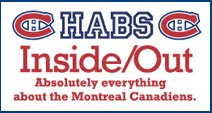





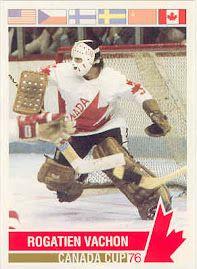
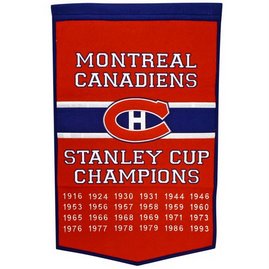







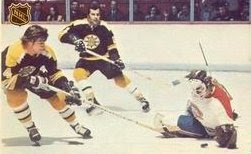



















































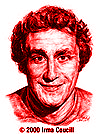



































































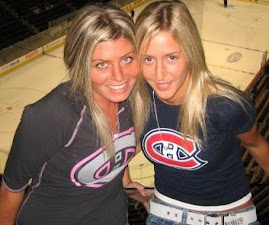


















No comments:
Post a Comment